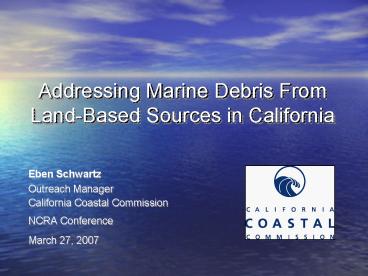Addressing Marine Debris From LandBased Sources in California - PowerPoint PPT Presentation
1 / 19
Title: Addressing Marine Debris From LandBased Sources in California
1
Addressing Marine Debris From Land-Based Sources
in California
- Eben Schwartz
- Outreach Manager
- California Coastal Commission
- NCRA Conference
- March 27, 2007
2
Marine Debris What is it?
- Marine Debris Any manufactured or processed
solid waste material that enters the marine
environment from any source. - Debris is everywhere found around every major
body of water on the planet, and below water as
well. - Marine Debris is a global pollution problem that
impacts human health and safety, endangers
wildlife and aquatic habitats, and costs local
national economies millions in wasted resources
and lost revenues.
3
Main Sources of Marine Debris
- Approximately 20 comes from ocean-based sources
- Commercial fishing vessels
- Cargo ships (discharge of containers and
garbage) - Pleasure cruise ships
4
Main Sources of Marine Debris
- Approximately 80 comes from land-based sources
- Litter (pedestrians, motorists, beach visitors)
- Industrial discharges (pellets and powders)
- Garbage management (containers, trucks, landfills)
5
(No Transcript)
6
Los Angeles River
7
Ballona Creek
8
Marine Debris Composition
- Shoreline Debris
- Between 60 80 percent comes from inland sources
(including stormwater discharge, beach visitors,
and non-point source pollution.) - 60 percent of shoreline debris is composed of
plastic. - Ocean Debris
- Plastic accounts for over 3/4 of all debris found
in the marine environment - 90 of floating litter is plastic
- Plastic is prevalent in at all depths, from the
surface of the ocean through the water column and
in sediments (Southern CA Coastal Water Research
Project)
9
California Coastal Cleanup Day
- Largest volunteer event in the state
- 2006 Results
- 50,375 volunteers.
- 944,885 pounds of debris
- 2,100 linear miles of shoreline cleaned.
- Since 1985
- 750,000 volunteers.
- 12 million pounds of debris removed.
10
Plastic Debris, Rivers to Sea Project
- Research (Algalita Marine Research Foundation)
- Extent to which urban runoff in Los Angeles and
San Gabriel River watersheds are impacted by
small plastic debris (mostly industrial runoff) - Determine effectiveness of voluntary best
management practices implemented by plastics
processing facilities - Awareness / Dialogue / Planning (CCC)
- Multi-stakeholder advisory board
- Educate stakeholders- NETWORK / LISTSERVE
- Plastic Debris, Rivers to Sea Conference Sept.
7-9, 2005 - Develop action plan for state
- Funding California Waterboards, Proposition 13
grant
11
(No Transcript)
12
Statewide Effort in Process
- California Coastal Commission led the effort to
develop An Action Plan to Reduce Land-Based
Discharges of Marine Debris in California - Worked with wide array of potential
implementers representing industry, government,
and environmental community - Available on www.plasticdebris.org
13
Voluntary Efforts by Plastics Industry
- Voluntary program of best management practices
to control pellet and powder loss - In existence since 1980s, not widely implemented
- Renewed industry commitment evident as a result
of AMRF research and industry/government/
environmental spirit of collaboration
14
Bag Reduction/Recycling Efforts
- Progressive Bag Alliance efforts in City of L.A.
- Working with supermarket chains to reduce bag use
- Training employees to pack more items and single
bag - Developed thicker bags printed messages on bags
- Promoting bag re-use through customer education
- In-store bag collection for recycling
- Promoting bag-to-bag recycling
- City of San Juan Capistrano - Bag-2-Bag Recycling
- When City of San Juan Capistrano banned
polystyrene, industry got proactive - Hilex Poly and CRR joined city in collaborative
effort to collect bags curbside and recycle them
into new bags - All 8,500 homes received blue bucket and years
supply of blue bags for collection
15
At CRRs recycling facility in Stanton, the blue
bags full of plastic bags arrive for sorting.
16
Other Local Initiatives
- Cities of San Clemente and Dana Point joined
Bag-2-Bag Program in June 2005 - City of San Jose developing curbside plastic bag
collection program - Smoke free beach initiatives being implemented in
cities up and down coast - Polystyrene bans (Huntington Beach, Malibu, Santa
Cruz, San Clemente, San Juan Capistrano, Santa
Monica) - Many municipalities installing structural storm
water controls (screens, nets, catch basin
inserts) to collect trash from urban runoff - Dont Trash California and Erase the Waste
education campaigns
17
Statewide Effort in Process
- Feb. 8, 2007 The Ocean Protection Council
adopts resolution to reduce and prevent marine
debris. Resolution includes - Consideration of expanding the California
Redemption Value Program - Commitment to increased enforcement of existing
litter laws, in particular violations involving
pre-production plastic pellets known as nurdles - Expansion of beach and river cleanups
- Regional coordination with Washington, Oregon,
British Columbia, Hawaii, and Baja California - Creation of a proposal for reducing derelict
fishing gear - Development of a statewide plan for reducing
single-use packaging and containers and a
proposal for a phased-in ban of toxic materials
used in plastic packaging by 2015. - Statewide Task Force currently meeting to develop
plans and adopt actions to implement this
resolution Coastal Commission is chairing the
Task Force - Resolution text available at www.resources.ca.gov/
copc
18
Recovery of Plastics in CA
Plastic waste generation versus recovery
(recycling)- CIWMB
19
(800) COAST-4U www.coast4u.org































